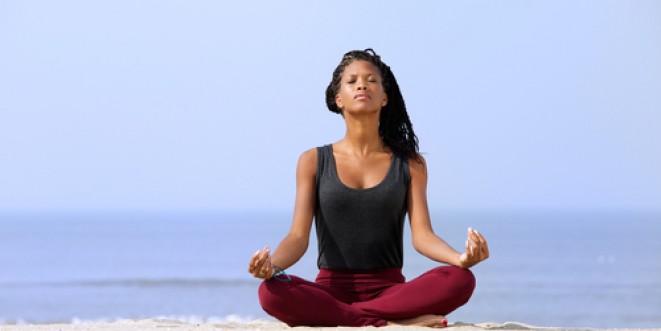Hatha, Vinyasa, Hot Yoga: Making Sense of It All
By Ejiro OgenyiPublished: June 4, 2014

Are you are interested in yoga but confused about the different yoga styles and exactly what they entail? Do you want to be in the know so you’re not totally clueless when you make it to the yoga studio? Join me on a tour of what I consider to be the core five yoga forms out there today. This tour will help you determine the best form of yoga to practice for your specific lifestyle goal or to suit your mood on any given day.
Hatha Yoga
All forms of yoga are Hatha Yoga. Hatha Yoga is the physical aspect of yoga and is also referred to as Asana. Its primary purpose is to prepare you for sitting in meditation for long periods of time. Whether or not you choose to meditate, Hatha Yoga can be a great way to engage in physical activity.
I consider any class that doesn’t fall into the other four forms as Hatha Yoga. So if you are planning to take a Hatha class, you can get an idea of what to expect by a process of elimination. Also if you want to engage in a yoga practice and none of the alternatives appeal to you, Hatha is a good place to start.
Vinyasa Flow
Vinyasa Yoga a.k.a. Power Vinyasa Yoga is a vigorous and athletic form of yoga. In Vinyasa Yoga, you spend a lot of time moving with breath as you transition through poses. While there is a lot of flow with periods where you hold poses and focus on breathing and building heat.
If you want to push personal boundaries and are comfortable (or want to get comfortable) with uncertainty, Vinyasa Flow will be perfect for you. Most Vinyasa Flow teachers incorporate challenging Arm Balances and fun variations of Standing Postures into their sequencing, and because you are moving almost nonstop, you are less likely to get caught up in your ideas about what you are capable of and you just do it.
Ashtanga Yoga
Similar to Vinyasa, Ashtanga is also vigorous and athletic. But unlike Vinyasa, Ashtanga Yoga has a set sequence. The sequences for Ashtanga are divided into the Primary Series, the Secondary Series, and the Advanced Series. The practice also focuses on moving with breath with holds that are typically five breaths long in key postures through the practice.
If you are interested in guided mastery, where you progress over time, an Ashtanga practice can be ideal for you. You start at the beginning and can spend years mastering the Primary Series, so this practice is fantastic for cultivating patience while slowly detangling barriers as you advance within and through each series.
Restorative Yoga
Like the name, Restorative Yoga is all about resting and restoring. You spend a lot of time on the floor and the practice tends to utilize many props such as bolsters, blocks, mats, and straps. If you are injured, stressed, or just need to show your body some love, this is the place you want to be.
You don’t necessarily have to wait till you get stressed or injured to reap the benefits of a Restorative practice; interweaving it into a regular regimen of cardio, strength training, and a Vinyasa practice can help keep injuries at bay and keep you feeling fresh even if you do this only once a month.
Hot Yoga
Hot Yoga is a generic term for yoga practices that are done in an artificially heated room. If you have heard of Bikram Yoga or Baptiste Power Vinyasa Yoga, these two utilize heat to help you open up your muscles and take you deeper into a flexibility practice. It can be practiced in as hot as 41oC (105oF) or a more moderate 35oC (95oF). This practice is for you if you are looking for an added challenge in the form of heat. Hot Yoga classes require that you pay attention to how you feel and take rest when you need it.
Be careful in your first few classes because the heat makes your muscles more pliable than they normally are and you might overstretch them if you don’t temper your heat-enabled flexibility. You also want to stay hydrated due to the heat in the room, so make sure you have a bottle (or two) of water handy.
Choosing a style of yoga to practice depends on your personal preferences, your goals, and the other forms of exercises you engage in. Don’t feel pressure to pick one particular style. You can move between styles based on what your body needs. For example, you can choose the more vigorous Vinyasa when your energy levels are up but choose to go for a restorative class after a hard day at work.
Regardless of the form you choose, listening to your body during class is a requirement as it keeps injury at bay and helps you reap the stress-reducing benefits of the practice.
Like what you're reading? Sign up for our free newsletter and never miss a post! Plus get a FREE digital version of our Issue No.10 with sign up.

- How To Get The Most Benefit From Your Jog (or Run) Exercise - September 9, 2014
- My Pregnancy Journey: Battling and Overcoming Depression - February 16, 2015
- Three Steps To Make Exercise A Habit - August 26, 2014
- 4 Ways Exercise Can Boost Your Career - June 14, 2016
- 3 Top Tips to Avoid Workout Burnout - June 7, 2016
- 3 Tips To Avoid Post Wedding Weight Gain - September 17, 2014
- Are Your Vigorous Workouts Stalling Your Progress? - April 26, 2016
- Before & After Post-Parturm Body Transformation - February 23, 2016
- Why Your Workout Is Not Working And What You Can Do About It - August 20, 2014
- 3 Ways Yoga Can Change Your Life - May 6, 2014












